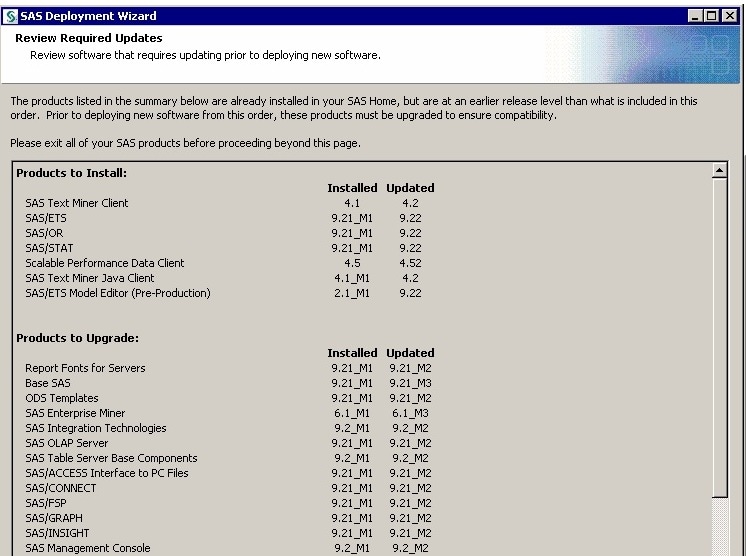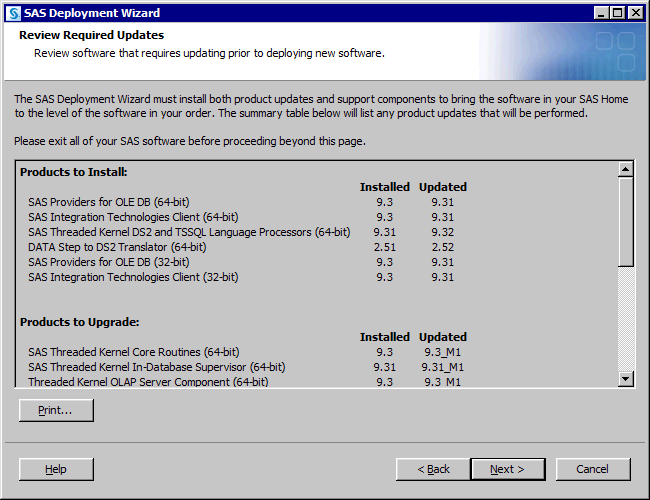Installation Note 40324: When installation and configuration are performed separately, the SAS® Deployment Wizard goes into Update mode
 |  |  |
If you perform a new installation using the SAS Deployment Wizard and you choose to perform the configuration at a later time, it is possible that the SAS Deployment Wizard will not allow you to select the Configure option when you attempt the configuration steps. Instead, the SAS Deployment Wizard goes into Update mode to apply maintenance.
This behavior is expected.
Once the software has been installed, the SAS Deployment Wizard automatically compares the software installation with the software that is available in the depot, and it checks for updates.
In addition to checking the version of the installed software, the SAS Deployment Wizard checks the version of components that might be required by the installed software. It does this so that interdependent software is always up-to-date and so that any newly required components are seamlessly included with updates.
In a valid configuration, all interdependent components might not be installed on all tiers. For example, the configuration might need only one installed instance of a component. However, when the SAS Deployment Wizard is run a second time and performs its automatic check for updates and detects an interdependency, it enters Update mode to add the related component if it is not already installed.
Note that this can happen even if you are installing from the same SAS Software Depot and the same revision of SAS.
Here is an example of the display that you see for the required
updates in SAS 9.2:

Assessing the Effect on Products at Your Site
How to Install and Configure a New Product Release
Understanding Product Upgrades and Product Installs
This update behavior is new with SAS 9.2 (TS2M3) revision 10w34 and later.
Here is an example of the display that you see for the required updates in SAS 9.3:

Operating System and Release Information
| Product Family | Product | System | SAS Release | |
| Reported | Fixed* | |||
| SAS System | N/A | 64-bit Enabled Solaris | 9.2 TS2M3 | |
| Solaris for x64 | 9.2 TS2M3 | |||
| Microsoft® Windows® for 64-Bit Itanium-based Systems | 9.2 TS2M3 | |||
| Microsoft Windows Server 2003 Datacenter 64-bit Edition | 9.2 TS2M3 | |||
| Microsoft Windows Server 2003 Enterprise 64-bit Edition | 9.2 TS2M3 | |||
| Microsoft® Windows® for x64 | 9.2 TS2M3 | |||
| Microsoft Windows Server 2003 Datacenter Edition | 9.2 TS2M3 | |||
| Microsoft Windows Server 2003 Enterprise Edition | 9.2 TS2M3 | |||
| Microsoft Windows Server 2003 Standard Edition | 9.2 TS2M3 | |||
| Microsoft Windows Server 2003 for x64 | 9.2 TS2M3 | |||
| Microsoft Windows Server 2008 | 9.2 TS2M3 | |||
| Microsoft Windows Server 2008 for x64 | 9.2 TS2M3 | |||
| Microsoft Windows XP Professional | 9.2 TS2M3 | |||
| Windows 7 Enterprise 32 bit | 9.2 TS2M3 | |||
| Windows 7 Enterprise x64 | 9.2 TS2M3 | |||
| Windows 7 Home Premium 32 bit | 9.2 TS2M3 | |||
| Windows 7 Home Premium x64 | 9.2 TS2M3 | |||
| Windows 7 Professional 32 bit | 9.2 TS2M3 | |||
| Windows 7 Professional x64 | 9.2 TS2M3 | |||
| Windows 7 Ultimate 32 bit | 9.2 TS2M3 | |||
| Windows 7 Ultimate x64 | 9.2 TS2M3 | |||
| Windows Vista | 9.2 TS2M3 | |||
| Windows Vista for x64 | 9.2 TS2M3 | |||
| 64-bit Enabled AIX | 9.2 TS2M3 | |||
| 64-bit Enabled HP-UX | 9.2 TS2M3 | |||
| HP-UX | 9.2 TS2M3 | |||
| HP-UX IPF | 9.2 TS2M3 | |||
| Linux | 9.2 TS2M3 | |||
| Linux for x64 | 9.2 TS2M3 | |||
| Linux on Itanium | 9.2 TS2M3 | |||
| OpenVMS on HP Integrity | 9.2 TS2M3 | |||
| Tru64 UNIX | 9.2 TS2M3 | |||